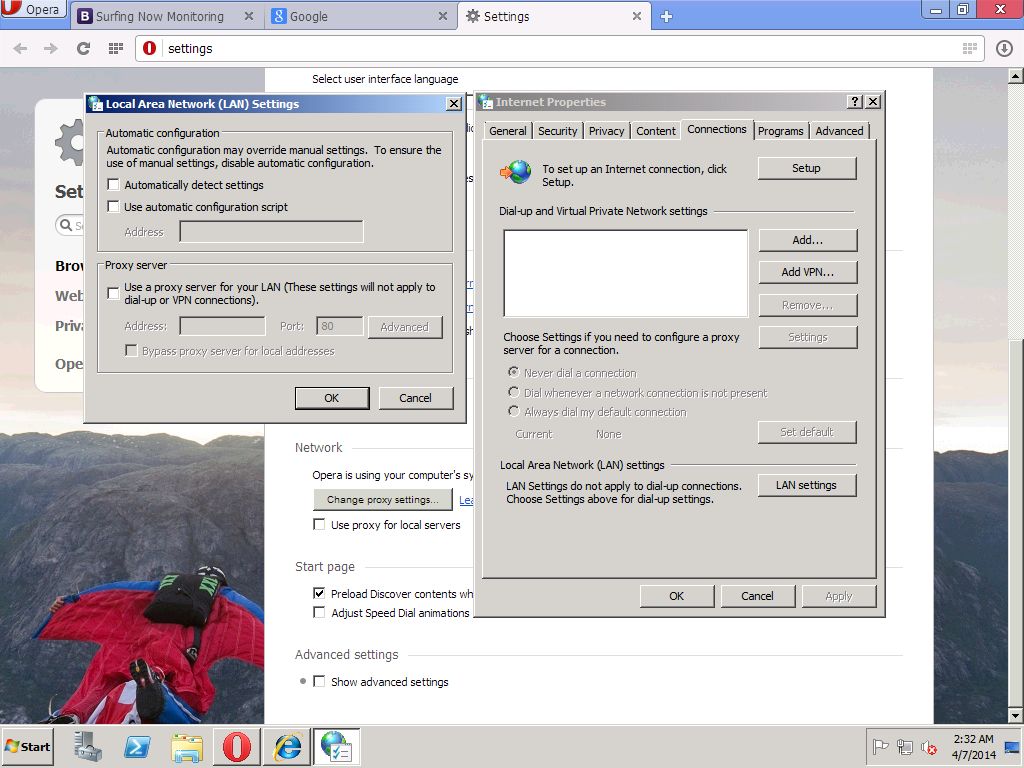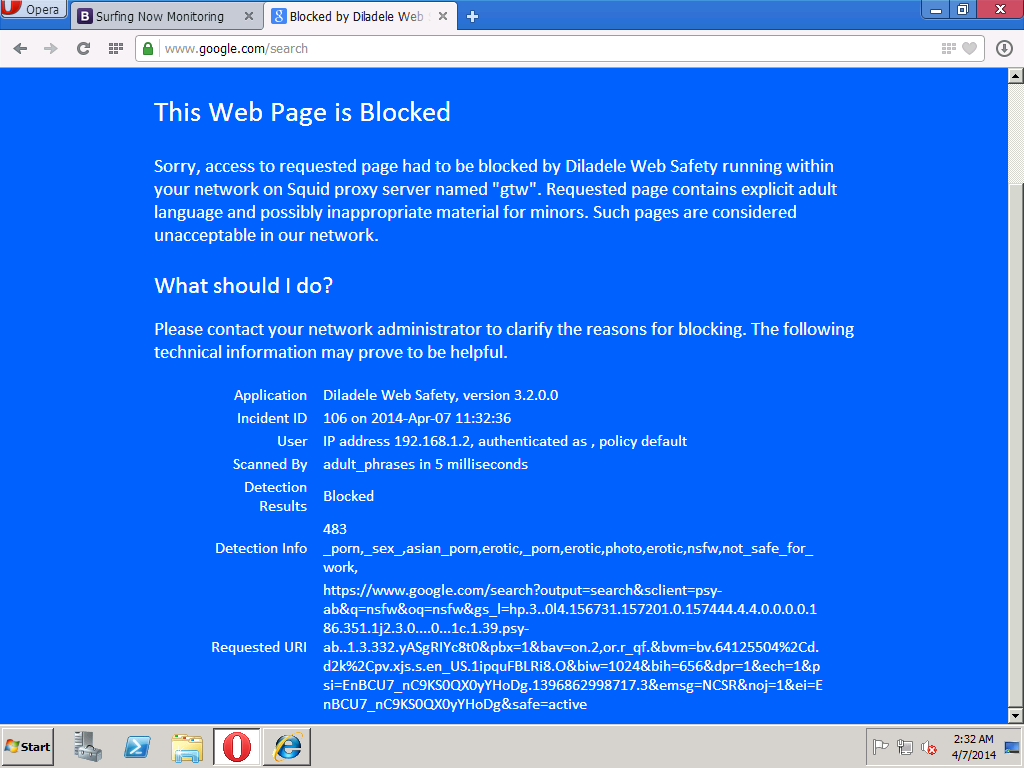How to set up a transparent HTTPS filtering proxy on CentOS
Last updated on October 2, 2020 by Dan Nanni
HTTPS protocol is used more and more in today's web. While this may be good for privacy, it leaves modern network administrator without any means to prevent questionable or adult contents from entering his/her network. Previously it was assumed that this problem does not have a decent solution. Our how-to guide will try to prove otherwise.
This guide will tell you how to set up Squid on CentOS / RedHat Linux for transparent filtering of HTTP and HTTPS traffic with help of Diladele Web Safety ICAP server, which is a commercial solution for Linux, BSD and MacOS. The Linux installer of Diladele Web Safety used in this tutorial contains fully featured keys which remain valid for 3 month period, so you can test its full features during this trial period.
Assumptions and Requirements
In this tutorial, I will assume the following. You have a network with IP addresses from 192.168.1.0 subnet, network mask is 255.255.255.0, and all workstations are set to use 192.168.1.1 as default gateway. On this default gateway, you have two NICs - one facing LAN with IP address 192.168.1.1, the other is plugged in into ISP network and gets its public Internet address through DHCP. It is also assumed your gateway has CentOS or RedHat Linux up and running.
Step 1. Update and Upgrade
Before going further, run the following script to upgrade your system to the most recent state.
#!/bin/bash set -e # update should be done as root if [[ $EUID -ne 0 ]]; then echo "This script must be run as root" 1>&2 exit 1 fi # update and upgrade yum update && yum upgrade # disable selinux sed -i s/SELINUX=enforcing/SELINUX=disabled/g /etc/selinux/config # and reboot reboot
Step 2. Install Apache Web Server
Diladele Web Safety has sophisticated a web administrator console to easily manage filtering settings and policies. This Web UI is built using Python Django web framework, and requires Apache web server to function correctly. Run the following script to install them.
#!/bin/bash set -e # all web packages are installed as root if [[ $EUID -ne 0 ]]; then echo "This script must be run as root" 1>&2 exit 1 fi # install python libs yum install python-setuptools python-ldap # install python django for web ui easy_install django==1.5 # install apache web server to run web ui yum install httpd php mod_wsgi # make apache autostart on reboot chkconfig httpd on # this fixes some apache errors when working with python-django wsgi echo "WSGISocketPrefix /var/run/wsgi" >> /etc/httpd/conf.d/wsgi.conf # and restart apache service httpd restart
Step 3. Install Diladele Web Safety
Download and install the latest version of Diladele Web Safety using the following script.
#!/bin/bash
# all packages are installed as root
if [[ $EUID -ne 0 ]]; then
echo "This script must be run as root" 1>&2
exit 1
fi
# detect current architecture (default assumes x86_64)
ARCH_1=`uname -m`
ARCH_2="amd64"
if [[ $ARCH_1 == 'i686' ]]; then
ARCH_1="i386"
ARCH_2="i386"
fi
# bail out on any error
set -e
# get latest qlproxy
curl http://updates.diladele.com/qlproxy/binaries/3.2.0.4CAF/$ARCH_2/release/centos6/qlproxy-3.2.0-4CAF.$ARCH_1.rpm > qlproxy-3.2.0-4CAF.$ARCH_1.rpm
# install it
yum -y --nogpgcheck localinstall qlproxy-3.2.0-4CAF.$ARCH_1.rpm
# qlproxy installed everything needed for apache, so just restart
service httpd restart
Step 4. Install Required Build Tools
To be able to perform HTTP/HTTPS transparent filtering, we need to get the latest version of Squid (the one that comes with CentOS / RedHat by default is too outdated), and rebuild it from source. The following script installs all build tools required.
#!/bin/bash # install all build tools if [[ $EUID -ne 0 ]]; then echo "This script must be run as root" 1>&2 exit 1 fi # install development packages required yum install -y gcc-c++ pam-devel db4-devel expat-devel libxml2-devel libcap-devel libtool redhat-rpm-config rpm-build openldap-devel openssl-devel krb5-devel # squid needs perl and needs additional perl modules not present by default in CentOS 6 curl http://dl.fedoraproject.org/pub/epel/6/x86_64/epel-release-6-8.noarch.rpm > epel-release-6-8.noarch.rpm rpm -Uvh epel-release-6*.rpm yum install -y perl-Crypt-OpenSSL-X509
Step 5. Build Squid from Source
Rebuild the Squid RPM by running the following script.
#!/bin/bash # stop on any error set -e # rpm build MUST be run as normal user if [[ $EUID -eq 0 ]]; then echo "This script must NOT be run as root" 1>&2 exit 1 fi # get squid sources pushd rpmbuild/SOURCES curl http://www.squid-cache.org/Versions/v3/3.4/squid-3.4.4.tar.xz > squid-3.4.4.tar.xz curl http://www.squid-cache.org/Versions/v3/3.4/squid-3.4.4.tar.xz.asc > squid-3.4.4.tar.xz.asc popd # build the binaries RPMs out of sources pushd rpmbuild/SPECS rpmbuild -v -bb squid.spec popd
Step 6. Install Squid
After build finishes, install Squid. It is advisable to uncomment the lines which generate your own root certification authority. Default installation of Diladele Web Safety does have its own ca, but trusting it may pose serious security risk if your devices are used by users outside of your network.
#!/bin/bash
# stop on every error
set -e
# install RPMs as root
if [[ $EUID -ne 0 ]]; then
echo "This script must be run as root" 1>&2
exit 1
fi
# detect current architecture (default assumes x86_64)
ARCH_1=`uname -m`
ARCH_2="amd64"
ARCH_3="lib64"
if [[ $ARCH_1 == 'i686' ]]; then
ARCH_2="i386"
ARCH_3="lib"
fi
pushd rpmbuild/RPMS/$ARCH_1
yum localinstall -y squid-3.4.4-0.el6.$ARCH_1.rpm
popd
# set up the ssl_crtd daemon
if [ -f /bin/ssl_crtd ]; then
rm -f /bin/ssl_crtd
fi
ln -s /usr/$ARCH_3/squid/ssl_crtd /bin/ssl_crtd
/bin/ssl_crtd -c -s /var/spool/squid_ssldb
chown -R squid:squid /var/spool/squid_ssldb
# uncomment to regenerate certificates for SSL bumping if you do not like defaults
# openssl req -new -newkey rsa:1024 -days 1365 -nodes -x509 -keyout myca.pem -out myca.pem
# openssl x509 -in myca.pem -outform DER -out myca.der
# then copy certificates
# cp myca.pem /etc/opt/quintolabs/qlproxy/
# cp myca.der /etc/opt/quintolabs/qlproxy/
# make squid autostart after reboot
chkconfig squid on
Step 7. Integrate Squid with Diladele Web Safety
Integrate Squid and Diladele Web Safety by running the following script.
#!/bin/bash # stop on any error set -e # integration should be done as root if [[ $EUID -ne 0 ]]; then echo "This script must be run as root" 1>&2 exit 1 fi # allow web ui read-only access to squid configuration file chmod o+r /etc/squid/squid.conf # perform integration by replacing squid.conf file mv /etc/squid/squid.conf /etc/squid/squid.conf.original && mv squid.conf /etc/squid/squid.conf # parse the resulting config just to be sure /usr/sbin/squid -k parse # restart squid to load all config /sbin/service squid restart
Step 8. Transparently Redirect HTTPS Traffic to Squid
Transparent filter for HTTP and HTTPS traffic will be implemented by redirecting traffic to ports 80 and 443 to Squid using iptables. This implies that the box with Squid acts as default gateway for your LAN. Please note this is only one way to implementing transparent filtering. Other possible solutions are described in Squid’s Wiki.
#!/bin/bash
# firewall setup should be done as root
if [[ $EUID -ne 0 ]]; then
echo "This script must be run as root" 1>&2
exit 1
fi
# check kernel forwarding is enabled
enabled=`cat /proc/sys/net/ipv4/ip_forward`
if [[ $enabled -ne 1 ]]; then
echo "Kernel forwarding seems to be disabled, enable it in /etc/sysctl.conf, reboot and rerun this script" 1>&2
exit 1
fi
# set the default policy to accept first (not to lock ourselves out from remote machine)
iptables -P INPUT ACCEPT
# flush all current rules from iptables
iptables -F
# allow pings from eth0 and eth1 for debugging purposes
iptables -A INPUT -p icmp -j ACCEPT
# allow access for localhost
iptables -A INPUT -i lo -j ACCEPT
# accept packets belonging to established and related connections
iptables -A INPUT -m state --state ESTABLISHED,RELATED -j ACCEPT
# allow ssh connections to tcp port 22 from eth0 and eth1
iptables -A INPUT -p tcp --dport 22 -j ACCEPT
# allow connection from LAN to ports 3126, 3127 and 3128 squid is running on
iptables -A INPUT -i eth0 -p tcp --dport 3126 -j ACCEPT
iptables -A INPUT -i eth0 -p tcp --dport 3127 -j ACCEPT
iptables -A INPUT -i eth0 -p tcp --dport 3128 -j ACCEPT
# redirect all HTTP(tcp:80) traffic coming in through eth0 to 3126
iptables -t nat -A PREROUTING -i eth0 -p tcp -m tcp --dport 80 -j REDIRECT --to-ports 3126
# redirect all HTTPS(tcp:443) traffic coming in through eth0 to 3127
iptables -t nat -A PREROUTING -i eth0 -p tcp -m tcp --dport 443 -j REDIRECT --to-ports 3127
# configure forwarding rules
iptables -A FORWARD -i eth0 -o eth1 -p tcp --dport 22 -j ACCEPT
iptables -A FORWARD -i eth1 -o eth0 -p tcp --sport 22 -j ACCEPT
iptables -A FORWARD -p icmp -j ACCEPT
iptables -A FORWARD -i eth0 -o eth1 -p tcp --dport 80 -j ACCEPT
iptables -A FORWARD -i eth1 -o eth0 -p tcp --sport 80 -j ACCEPT
iptables -A FORWARD -i eth0 -o eth1 -p tcp --dport 53 -j ACCEPT
iptables -A FORWARD -i eth0 -o eth1 -p udp --dport 53 -j ACCEPT
iptables -A FORWARD -m state --state ESTABLISHED,RELATED -j ACCEPT
iptables -A FORWARD -j REJECT --reject-with icmp-host-prohibited
# enable NAT for clients within LAN
iptables -t nat -A POSTROUTING -o eth1 -j MASQUERADE
# set default policies for INPUT, FORWARD (drop) and OUTPUT (accept) chains
iptables -P INPUT DROP
iptables -P FORWARD DROP
iptables -P OUTPUT ACCEPT
# list created rules
iptables -L -v
# save the rules so that after reboot they are automatically restored
/sbin/service iptables save
# enable the firewall
chkconfig iptables on
# and reboot machine
reboot
Check if HTTPS is Transparently Filtered
Please note, in order for HTTPS filtering to function correctly, we must install the proxy certificate from /etc/opt/quintolabs/qlproxy/myca.der into Trusted Root Certification on all workstations in our network. The following screenshots show that HTTPS requests were decrypted and filtered transparently.


Browsing to Google and searching for an adult term (e.g. NSFW), we get the HTTPS request filtered and blocked transparently.

Resume
We now have the default gateway in our network capable of transparently filtering HTTP and HTTPS traffic. All workstations in our network trust the root certificate from proxy, and thus get their HTTPS request decrypted and filtered. Browsing environment in our network became much safer. Refer to the documentation of Diladele Web Safety for more details.
Support Xmodulo
This website is made possible by minimal ads and your gracious donation via PayPal or credit card
Please note that this article is published by Xmodulo.com under a Creative Commons Attribution-ShareAlike 3.0 Unported License. If you would like to use the whole or any part of this article, you need to cite this web page at Xmodulo.com as the original source.
Xmodulo © 2021 ‒ About ‒ Write for Us ‒ Feed ‒ Powered by DigitalOcean

